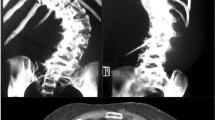Abstract.
This paper examines the following speculative hypothesis: "that in some patients with scoliosis there is disproportionate neuro-osseous growth – the longitudinal growth of the spinal cord fails to keep pace with the growth of the vertebral column and, as a consequence, the spine buckles into a scoliosis deformity". A literature review of the morphology and neurology of scoliosis does not deny the hypothesis. Several mechanisms are suggested as to why the spinal cord growth could become uncoupled from osseous growth.
Similar content being viewed by others
Author information
Authors and Affiliations
Additional information
Electronic Publication
Rights and permissions
About this article
Cite this article
Porter, R.W. The pathogenesis of idiopathic scoliosis: uncoupled neuro-osseous growth?. Eur Spine J 10, 473–481 (2001). https://doi.org/10.1007/s005860100311
Received:
Accepted:
Published:
Issue Date:
DOI: https://doi.org/10.1007/s005860100311




